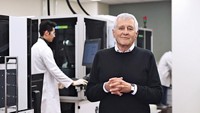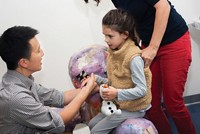Advertisement
Grab your lab coat. Let's get started
Welcome!
Welcome!
Create an account below to get 6 C&EN articles per month, receive newsletters and more - all free.
It seems this is your first time logging in online. Please enter the following information to continue.
As an ACS member you automatically get access to this site. All we need is few more details to create your reading experience.
Not you? Sign in with a different account.
Not you? Sign in with a different account.
ERROR 1
ERROR 1
ERROR 2
ERROR 2
ERROR 2
ERROR 2
ERROR 2
Password and Confirm password must match.
If you have an ACS member number, please enter it here so we can link this account to your membership. (optional)
ERROR 2
ACS values your privacy. By submitting your information, you are gaining access to C&EN and subscribing to our weekly newsletter. We use the information you provide to make your reading experience better, and we will never sell your data to third party members.
Rare Disease
Movers And Shakers
So you want to make a personalized drug? This company has got your back
Charles River Laboratories is rapidly testing the safety of several N-of-1 therapies. More are on the way
by Ryan Cross
December 12, 2019
| A version of this story appeared in
Volume 98, Issue 1
In 2002, Lauren Black had grown frustrated with her job. She had been working at the US Food and Drug Administration as a reviewer for just over a decade. “I saw too many resources wasted,” she says. Drug companies were submitting a surplus of animal studies along with excessive or simply irrelevant data. “I thought it was time to go out and work further upstream.”
So she took a job at Charles River Laboratories, a contract research organization (CRO) that drug companies turn to for animal models, toxicology studies, and more. In her 17 years there, Black has helped streamline research and package it into digestible forms for FDA review. And today, she’s taking that thinning to its most extreme form by leading the company’s role in developing N-of-1 therapies—drugs that are custom designed for a single individual’s exceedingly rare genetic mutation.

Although Charles River has been involved with only two N-of-1 therapies that have been given to humans—both of which Black helped usher through FDA review—more are on the way. For Charles River, these personalized drug programs stand out not because they benefit the firm’s bottom line but because they are largely paid for out of pocket by families trying to save a child or sibling. “We pushed really hard to minimize the amount of up-front expenditure to these families,” Black says.
And that largely means negotiating with the FDA for a smaller amount of preclinical work.
“We don’t want to sidestep anything necessary for a thorough safety characterization,” she adds. “But we cull the research down to the bare minimum and make sure the FDA is on board with that amount.”
Black’s bare-minimum mantra has earned Charles River a reputation as the go-to partner for families wanting to make their own N-of-1 therapies. She and others at the company are working on several more N-of-1 therapies for rare neurological diseases, and she’s guiding an even more ambitious effort to make the first custom CRISPR gene-editing therapy. It’s a brave new world for a firm that’s perhaps best known for selling mice.
Until recently, if you wanted to make a custom drug, there was no model to follow. That all changed in early 2017, when Boston Children’s Hospital geneticist Timothy Yu was introduced to 6-year-old Mila Makovec. Yu helped pinpoint the genetic root of Mila’s neurodegenerative condition, called Batten disease, and then devised an audacious plan: develop a treatment just for her in under a year. By mimicking the design of the approved drug Spinraza, an antisense oligonucleotide that turns on production of a protein missing in infants with spinal muscular atrophy, Yu’s lab quickly devised a new therapy, dubbed milasen.

Then he hit a roadblock. Before Mila could be given the drug, the FDA wanted to see 3 months of data showing that milasen was safe in rats. In September 2017, he was connected to Black, who explained that under normal circumstances, the rat toxicology study would take at least 9 months—a 3-month wait to start the study because of backlog, 3 months to do the study, and 3 more months to analyze the data and form a report. After that, Yu would have to wait for permission from the FDA to give Mila the drug.
But Mila’s disease was rapidly progressing.
“You’ve got to repitch this,” Black recalls telling Yu.
Black and her colleague Julie Douville devised an expedited plan to get Mila her drug in a matter of months instead of nearly a year. They carved out time from Charles River scientists’ schedules to work on experiments with milasen as soon as the drug was manufactured, even going as far as asking a company pathologist to block off a Saturday to come into the lab and review rat spines and brains for any evidence of toxicity from the drug.
Black also introduced Yu to two consultants—and former FDA employees—Sara Goldkind and Mary Pendergast. Together they drafted a request asking the FDA to review the milasen safety data on a rolling basis, meaning that FDA reviewers would green-light Mila’s first dose of her drug after reviewing the 7- and 21-day safety data from the rats, while Charles River continued to monitor the rats for 3 months for any longer-term safety concerns.
After a manufacturing holdup waylaid those carefully orchestrated plans, Douville had to convince people to work overtime through Christmas. It was a nerve-racking time for Mila’s mother, Julia Vitarello. “But in that last stretch, Charles River just completely stepped up,” she says.
Mila got her custom drug on Jan. 19, 2018, just 7 weeks after the first injection of the drug in rats. “I don’t think that’s ever been done before,” Black says.
The story of milasen has inspired other scientists and families to launch N-of-1 drug programs, and many of them are contacting Charles River for help. The firm conducted safety studies for jacifusen, the second N-of-1 drug, designed for a woman named Jaci Hermstad who has a rare form of amyotrophic lateral sclerosis (ALS).
Today, Black is working on antisense oligonucleotide projects for a dozen more rare neurological diseases. “Spinraza started this,” Black says. “And now we see the sea change coming.”
However, just because the FDA has approved a handful of N-of-1 drugs doesn’t necessarily make it easier to make more. Even Black herself, an evangelist for rapid drug development, has had to temper expectations. One group she talked to on the phone in September wanted her to draft an antisense drug development program on the spot. “Nobody can spin on a dime very often,” she says. Charles River has done it twice, for Mila and Hermstad, but it’s unclear how often the firm will be able to handle these massive undertakings.
What’s more, Black says the process is not always as simple as copying Spinraza’s template and just changing the nucleotide sequence it targets. Part of the reason for this is that biology is complex. A good example, Black says, is Angelman syndrome, a rare genetic condition characterized by intellectual disability and problems with movement and speech. The disease is caused by a missing or broken copy of the UBE3A gene from an individual’s mother.
Charles River is working with a small company called GeneTx Biotherapeutics that is developing an antisense oligonucleotide that turns on a normally silent paternal copy of UBE3A in parts of the brain. Although preclinical studies suggest the approach is promising, Black says they need to be cautious: if the drug alters transcription in the wrong way, it could cause a different genetic disease called Prader-Willi syndrome.
And although Angelman is rare, it’s not rare enough to justify an N-of-1 approach and a compassionate use request—which is the mechanism through which FDA approved the administration of milasen and jacifusen. At Charles River, the Angelman antisense project “is a much more conservative program,” Black says.
In addition to her antisense oligonucleotide projects, Black is helping with an even more ambitious goal: develop the first customized CRISPR gene-editing therapy. The project is led and funded by Rich Horgan, whose younger brother, Terry Horgan, has a rare form of Duchenne muscular dystrophy. Rich has recruited scientists from multiple academic institutions and medical centers to develop and test the experimental CRISPR therapy. In early 2020, Charles River will begin assessing the safety of the therapy in mice and help determine the dose that Terry should receive.
Time is of the essence for Terry, who at 24 has a weakening heart, and Black has advised Rich to forgo the large animal studies, such as dogs, which are standard in trials of muscular dystrophy drugs. She’s also advised against waiting for a rodent model that precisely recapitulates Terry’s disease, settling instead on a basic muscular dystrophy mouse model to test the CRISPR therapy’s safety. For evidence that it works, the researchers will simply test it in cells taken from a muscle biopsy in Terry and grown in a dish.
“We really developed a deep relationship with Charles River,” Rich says. Black is playing a particularly important role in the project, but Charles River isn’t helming any N-of-1 projects from start to finish. For the most part, families are working with academic researchers to make the diagnosis, design the drug, and ultimately administer the therapy. Other firms that specialize in oligonucleotide manufacturing are actually producing the drugs.
Charles River’s role is largely in conducting toxicology and dose-finding studies, providing regulatory expertise, and perhaps most importantly, pushing the limits of what a trimmed-down investigational new drug application can look like. These N-of-1 projects are insignificant to Charles River’s bottom line, for now. “The work they are doing for us is discounted and for a customer they hope they never see again,” Rich says.
Although the firm won’t disclose how much the N-of-1 projects cost or whether they are able to still turn a profit, Julie Frearson, corporate vice president of strategic alliances for Charles River says that the company is “putting management and governance systems in place” for future N-of-1 cases. “We do think there will continue to be a need for this approach as whole-genome sequencing diagnoses are rapid and ASO therapeutics are relatively fast to design and deploy.”
So what’s in it for Charles River? “It has made our workers feel so worthwhile,” Black says. “At a CRO, you often don’t have an insight of whether you are helping a patient or not. You don’t know a patient’s name. You don’t know if your project will help 200 people or 1,000.”
Mila and Hermstad changed that. Employees volunteered to work overtime for Mila’s drug. They held a bake sale to raise money for Mila’s family around Christmastime, and conducted a penny war—a fundraising competition—to raise money for Hermstad’s family. “There is tremendous employee engagement. That’s what’s in it for us,” Black says. “Hundreds of people can say that they worked on milasen here at Charles River, and they are very proud of that.”
CORRECTION
The photo credit for the image of Mila Makovec, Julia Vitarello, and Timothy Yu was updated on Dec. 17, 2019. The photo was supplied by Boston Children's Hospital, not by Charles River Laboratories.





Join the conversation
Contact the reporter
Submit a Letter to the Editor for publication
Engage with us on Twitter